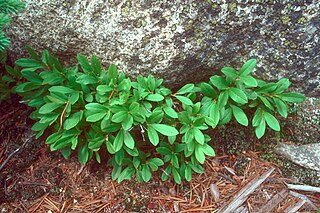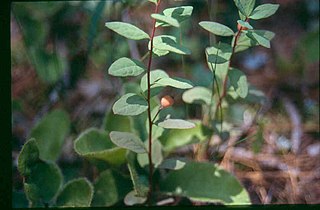
Cranberries are a group of evergreen dwarf shrubs or trailing vines in the subgenus Oxycoccus of the genus Vaccinium. In Britain, cranberry may refer to the native species Vaccinium oxycoccos, while in North America, cranberry may refer to Vaccinium macrocarpon. Vaccinium oxycoccos is cultivated in central and northern Europe, while Vaccinium macrocarpon is cultivated throughout the northern United States, Canada and Chile. In some methods of classification, Oxycoccus is regarded as a genus in its own right. They can be found in acidic bogs throughout the cooler regions of the Northern Hemisphere.

Vaccinium macrocarpon is a North American species of cranberry of the subgenus Oxycoccus and genus Vaccinium.

The northern red-backed vole is a small slender vole found in Alaska, northern Canada, Scandinavia and northern Russia.

Vaccinium erythrocarpum – also commonly known as mountain blueberry, southern mountain cranberry, bearberry, arando, and dingleberry – is a species of cranberry.

Vaccinium reticulatum, known as ʻōhelo ʻai in Hawaiian, is a species of flowering plant in the heather family, Ericaceae, that is endemic to Hawaii. It grows at altitudes of 640–3,700 m (2,100–12,140 ft) on lava flows and freshly disturbed volcanic ash on Maui and Hawaiʻi, and less commonly on Kauaʻi, Oʻahu, and Molokaʻi. Adaptations to volcanic activity include the ability to survive ash falls of over 25 cm (9.8 in) depth.
Dingleberry may refer to:

Vaccinium cespitosum, the dwarf bilberry, is a species of flowering shrub in the genus Vaccinium, which includes blueberries, huckleberries, and cranberries.
Mountain cranberry is a common name for several plants and may refer to:

Blueberries are perennial flowering plants with blue– or purple–colored berries. They are classified in the section Cyanococcus within the genus Vaccinium. Vaccinium also includes cranberries, bilberries, and huckleberries. Commercial "blueberries" – including both wild ('lowbush') and cultivated ('highbush') blueberries – are all native to North America. The highbush blueberry varieties were introduced into Europe during the 1930s.

Acrobasis vaccinii, the cranberry fruitworm, is a moth of the family Pyralidae described by Charles Valentine Riley in 1884. It is found in North America from Nova Scotia to Florida and from Wisconsin to Texas, it is introduced in the state of Washington.

Lycaena epixanthe, the bog copper or cranberry-bog copper, is a North American butterfly in the family Lycaenidae. Adults like to sip drops of dew clinging to leaves and almost exclusively nectar on their host plant, cranberries. Because of this, bog coppers will spend their entire lives within the area of a single acid bog. Even though their flight is weak and close to the ground, bog coppers are hard to catch because of the habitat in which they live. Also, 85% of the bog coppers life span is spent in the egg. It is listed as a species of special concern in the US state of Connecticut.
Anthonomus musculus, the cranberry weevil, is a pest of blueberries and cranberries Vaccinium macrocarpon Ait. in Massachusetts, New Jersey, Wisconsin, and Michigan. A. musculus is native to North America and ranges from New England to Florida and west of the Rocky Mountains.

Rhopobota naevana, the holly tortrix moth, holly leaf tier or blackheaded fireworm, is a moth of the family Tortricidae. It is found from Europe to eastern Russia, China, Taiwan, Mongolia, Korea and Japan. It is also present in India, Sri Lanka and North America.

Vaccinium caesariense is native to the Eastern United States. It is a species in the genus Vaccinium, which includes blueberries, cranberries, huckleberry, and bilberries.

Geocaulon is a monotypic genus of flowering plants in the family Santalaceae containing the single species Geocaulon lividum, which is known by the common names northern comandra and false toadflax. It is native to northern North America, where it is common and widespread from Alaska to Newfoundland and into the northernmost contiguous United States.
Vaccinium boreale, common name northern blueberry, sweet hurts or bleuet boréal, is a plant species native to the northeastern United States and eastern Canada. It has been reported from Québec, New Brunswick, Nova Scotia, Newfoundland & Labrador, Maine, New Hampshire, Vermont, and New York State. It grows in tundra, rocky uplands and in open conifer forests at elevations up to 2000 m.

Ideain, the cyanidin 3-O-galactoside, is an anthocyanin, a type of plant pigment.














